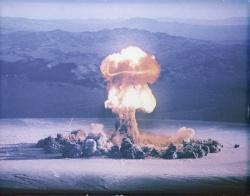The predominantly arid ecology of Nevada has created one of the greatest challenges facing the people of our region. Since the nineteenth century when the U.S. government first sent scientific expeditions to explore, map, and record the West, a voluminous record has been made of this landscape and the potential to both exploit and protect it.
Water has ruled urban development. In the beginning it was natural springs that attracted the earliest inhabitants and wells that supported early town development. Then the massive federal reclamation projects that dammed the Colorado River to irrigate the California and Arizona deserts. But the desert has supported destruction as well. In 1950 President Harry S. Truman approved the development of a continental nuclear proving ground 65 miles north of Las Vegas.
Featured Online Holdings



Water
With the unparalleled growth of the Las Vegas metropolitan area, the development of an urban and regional water system to support it has dominated natural resource planning and exploitation.
The basic issues of water use—its quantity, quality, and allocation—still dominate policy and politics in Nevada and the Southwest. Las Vegas still seeks to tap surface and ground water sources in outlying counties and adjoining states. And the original co-signers of the Colorado River Compact continue to wrangle over the allocations from Lakes Mead and Powell as the levels of those lakes drop precipitously.
See manuscript holdings on water
Urban Impact
We also hold hundreds of city, county, and state publications on historic preservation, urban planning, water and air quality, transportation, and other topics relating to the environment and quality of life. The majority of these are cataloged and are listed in the online catalog.
Urban development, often at the sacrifice of the natural environment, has sparked a growing concern, awareness, and activism on the part of environmental groups in Southern Nevada, who have sought to educate the public and protect the natural environment from the man-made encroachments and threats of highways, power lines, housing developments, nuclear testing, and the transportation and storage of nuclear waste.
See manuscript holdings about the environment
Nuclear Testing
The massive Yucca Mountain Project has generated perhaps the largest volume of scientific and government environmental impact studies of Southern Nevada. Both publications and manuscripts on nuclear testing and its effects on Southern Nevada can be found in Special Collections.
Dina Titus' Bombs in the Backyard (University of Nevada Press, 2001) is a standard work on nuclear testing, but there are many others as well.

